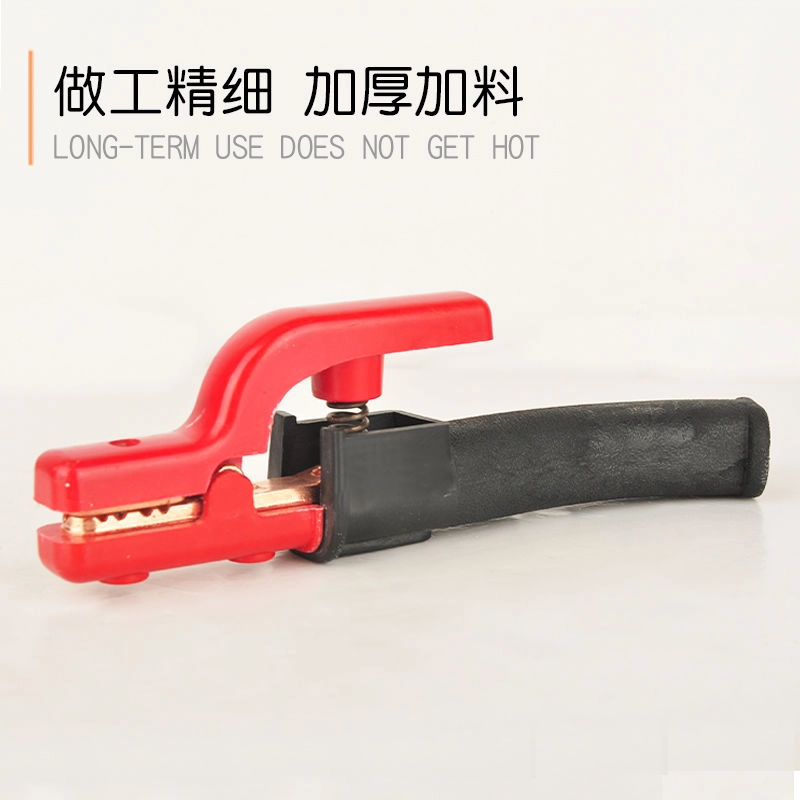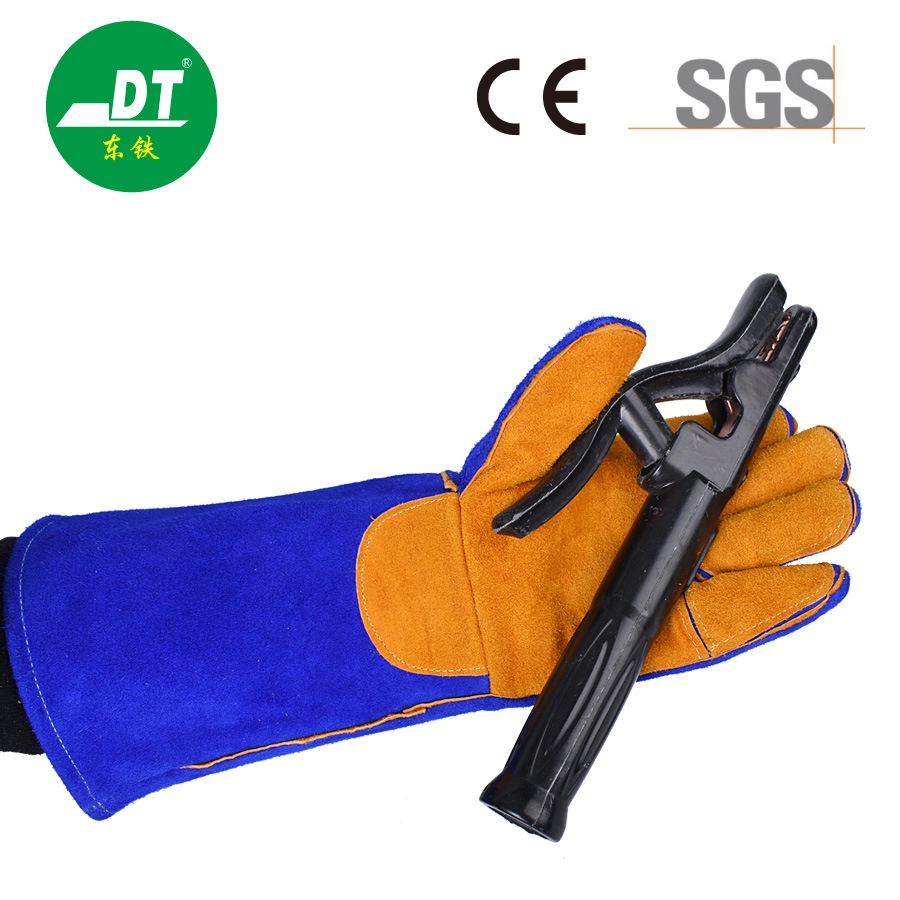The Ultimate Guide to the Standard Electrode Holder for Manual Arc Welding
In the world of manual welding, the tools you hold in your hands are your direct connection to the craft. Among the most crucial of these is the electrode holder, often called a "stinger." This device might seem simple, but it's the heart of the manual metal arc welding process. Choosing the right holder is vital for safety, efficiency, and the quality of your weld. This guide is here to demystify the standard electrode holder, explaining everything from design types and safety standards to maintenance tips, ensuring you can confidently select the best equipment for your needs.
What Exactly is an Electrode Holder and Why is it Vital for Arc Welding?
At its core, an electrode holder is a clamping device that the welder grips to hold the electrode and conduct the welding current to it. Think of it as the final, critical link in a powerful electrical circuit. This circuit starts at the welding machine, runs through a heavy-duty cable, passes through the holder, and finally travels down the electrode to create the arc that melts and fuses metal. Without a reliable holder, you simply cannot perform Shielded Metal Arc Welding (SMAW), also known as stick welding. It's an essential piece of welding equipment.
The importance of this device goes far beyond just holding the welding rod. A well-designed holder provides a secure grip on the electrode, ensuring a stable arc and a smooth weld. It must also be able to withstand extreme heat and high electrical currents while protecting the welder from electric shock. The quality of its construction directly impacts safety, comfort, and the ability to produce consistent, high-quality welds. It’s a component that demands respect and careful selection.
Tong-Type vs. Tweco-Style: Which Electrode Holder Design is Right for My Team?
When you start shopping for an electrode holder, you'll quickly notice two dominant styles: the tong-type and the Tweco-style (or twist-lock). Each design has its own set of fans and is suited for different preferences and applications. The classic tong-type holder, like the popular Lenco models, uses a lever-and-spring mechanism. Squeezing the handle opens the jaw, allowing you to insert or release the electrode. This design is straightforward, reliable, and allows for quick changes of the welding rod.
The Tweco-style holder, on the other hand, operates with a twisting motion. You insert the electrode into the head and then twist the handle to lock it in place. Many welders find this provides a more secure, positive grip, reducing the chances of the electrode slipping, especially when bending it to reach awkward angles. The choice between them often comes down to personal preference. A welder who does a lot of flat or horizontal welding might prefer the speed of a tong-type, while someone doing overhead or out-of-position work might value the secure lock of a twist-type holder. A popular model in this category is the Duro holder.

How Do I Choose the Right Amperage Rating for My Holder?
Selecting the correct amperage rating is one of the most important decisions when choosing an electrode holder. The amperage rating, or amp rate, indicates the maximum current the holder can safely handle. Using a holder with an amperage rating lower than the output of your welding machine is incredibly dangerous. It can cause the holder to overheat, melting the insulation and creating a severe risk of electric shock or burns.
To make the right choice, you need to know two things: the amperage you’ll be welding with and the duty cycle. The duty cycle is the percentage of a 10-minute period that a holder can operate at its maximum amperage without overheating. For example, a 250 amp holder with a 60% duty cycle can run at 250 amps for 6 minutes before it needs to cool down for 4 minutes. Always choose a holder with an amperage rating that meets or exceeds the current required by your most common welding tasks. It's better to have a higher-rated holder than one that's pushed to its limits. This ensures a long service life for your equipment and, more importantly, keeps you safe.
Understanding the IEC 60974 Standard: What Does it Mean for Electrode Holders?
When you see a reference to a standard like IEC 60974, it’s a mark of quality and safety. This specific publication from the International Electrotechnical Commission outlines the safety and performance requirements for welding equipment, including those for arc welding and cutting. Part 11 of this document, specifically IEC 60974-11, details the performance requirements of electrode holders. This is the global benchmark for ensuring a holder is built to a safe and reliable specification.
This regulation covers everything from the materials used to the electrical insulation properties and the mechanical strength of the holder. For a procurement officer like Mark Thompson, sourcing products that adhere to this standard is crucial. It guarantees that the holders for manual metal arc welding meet international safety criteria, protecting the end-user and reducing company liability. For instance, the second edition of this standard provides clear guidelines on testing procedures. When evaluating suppliers, always ask for proof of compliance with the relevant IEC standard.
What are the Key Construction Features of a Quality Barrel and Jaw System?
The heart of any good electrode holder is its barrel and jaw system. This is where the business end of the tool gets its strength and conductivity. High-quality holders typically feature a jaw made from a high-conductivity copper alloy casting. This ensures excellent electrical transfer from the cable to the electrode, minimizing resistance and heat buildup in the holder itself. The jaw is also designed with a specific groove (or multiple grooves) at different angles to securely hold the electrode in various positions, giving the welder flexibility.
The overall construction of the holder should feel robust and durable. The handle, or barrel, is typically made from a heat-resistant, non-conductive composite material. It should provide a comfortable and secure grip even when wearing thick welding gloves. Some premium models might include an ejector mechanism, which makes it easy to release the hot electrode stub without touching it. Pay close attention to these details, as they contribute significantly to the tool's performance, safety, and longevity.

Are Fully Insulated Holders Really Necessary for Welder Safety?
Yes, absolutely. A fully insulated holder is a non-negotiable safety feature in modern arc welding. The process of stick welding involves a live electrical circuit with potentially lethal voltage. The insulation on the holder is the primary barrier protecting the operator from coming into contact with this current. A quality holder will have robust, high-dielectric strength insulation covering all metal parts except for the very tip of the jaw where the electrode is held.
This protection is critical. Imagine accidentally touching the holder against the grounded workpiece or a metal workbench. Without proper insulation, this would create a dangerous short circuit, potentially damaging the equipment and posing a severe risk of electric shock. The purpose of the design is to insulate the welder from the current. Regular inspection of this insulation is a key part of routine maintenance. Any cracks, chips, or signs of wear mean the holder should be taken out of service immediately for repair or replacement. Never compromise on this crucial safety feature.
What Role Does the Cable Connection Play in Performance?
The connection between the welding cable and the electrode holder is a critical point in the welding circuit. A poor connection can cause a significant drop in current, leading to a weak arc, an inconsistent weld, and excessive heat buildup at the connection point. This can damage both the cable and the holder. You need a solid, secure way to connect the two components to ensure the entire system performs efficiently.
Most holders use a mechanical connection, such as a set screw or a crimp, to secure the copper wire of the welding whip inside the handle. It's vital that this connection is tight and clean. Some systems use a quick connect feature, allowing for easy swapping of holders or leads. Regardless of the method, the goal is the same: to create a low-resistance path for the electrical current to flow. Ensuring this connection is properly made and maintained will have a direct impact on your welding performance. The stability of the load on your welding machines can even be affected by a poor connection.
How Can Proper Maintenance Extend the Life of Your Welding Equipment?
Proper maintenance is key to getting the most out of your electrode holder and ensuring it operates safely. Stick welding is a rough process, and your equipment will see a lot of wear and tear. A few simple, regular checks can dramatically extend the life of your holder and prevent unexpected failures. Before each use, give your holder a quick visual inspection. Look for cracks or damage to the insulation, and check that the spring mechanism is working correctly.
The jaws of the holder are particularly prone to wear from heat and spatter. Keep them clean. Use a wire brush to remove any spatter buildup, as this can interfere with the electrical connection to the electrode. Also, periodically check the cable connection inside the handle to ensure it remains tight. A loose connection is a common source of overheating. Following a simple maintenance routine doesn't take long, but it will save you money on replacements and, more importantly, could prevent a serious safety incident. It’s a small investment of time for a big return in reliability and safety during any cutting or welding job.
Can One Electrode Holder Handle Every Type of Electrode?
Not necessarily. While many holders are versatile, you need to match the holder to the size of the electrode you're using. Electrode holders for manual metal arc welding are designed to accommodate a specific range of electrode diameters. For example, a light-duty holder might be suitable for electrodes up to 4 mm in diameter, while a heavy-duty holder used for industrial applications might be able to handle electrodes up to 10 mm in diameter. Using an electrode that is too small for the holder's jaw will result in a poor connection and an unstable arc.
Conversely, trying to force an electrode that is too large into the holder can damage the jaw mechanism. The product specifications for any given holder will always list its capacity. For example, a standard electrode holder might be rated for electrodes from 2.5 mm to 6.3 mm. When choosing a holder, consider the range of electrode sizes you use most frequently. For a shop that does a wide variety of work, it may be practical to have a couple of different-sized holders on hand to match the job, ensuring you always have the right tool for every type of manual metal arc welding.

Making the Final Decision: What to Look for in a Standard Electrode Holder Supplier?
For a business owner or procurement officer, choosing the right supplier for a fundamental item like an electrode holder is just as important as choosing the product itself. When you're sourcing equipment, you need a partner who understands the importance of quality, consistency, and compliance. Look for a supplier that can provide clear documentation of their products' adherence to international standards like IEC 60974. This demonstrates a commitment to safety and quality, which is essential for any reputable distributor of plasma cutting systems or welding supplies. You should look up relevant upcodes for your region.
Beyond certifications, consider the supplier's manufacturing capabilities and quality control processes. A reliable factory will have stringent checks in place to ensure every holder that leaves their line is free from defects. As a factory specializing in products like welding aprons and foot covers, we understand the critical nature of personal protective equipment and apply the same rigorous standards to all our products. Communication is also key. Your supplier should be responsive and knowledgeable, able to answer your technical questions and provide logistical support. A good supplier isn't just selling you a product; they are providing a reliable link in your supply chain. Look for a trusted brand, whether it be a well-known name like Bernard or a quality OEM manufacturer.
Key Takeaways for Choosing Your Electrode Holder:
- Match the Amperage: Always select an electrode holder with an amperage rating and duty cycle that meets or exceeds the output of your welding machine and the demands of your job.
- Prioritize Safety Standards: Insist on holders that comply with international safety standards like IEC 60974-11 to ensure they are properly tested and safe for use.
- Insulation is Non-Negotiable: Never use a holder with damaged or cracked insulation. A fully insulated body is your first line of defense against electric shock.
- Consider the Design: Choose between tong-type and twist-type holders based on welder preference and the type of work being performed.
- Check the Construction: Look for high-quality materials, such as a copper alloy jaw and a durable, heat-resistant handle, for longevity and performance.
- Maintain Your Equipment: Regular inspection and cleaning of the holder's jaws and cable connection will extend its life and ensure a better weld.
- Choose a Reliable Supplier: Partner with a manufacturer who values quality control, clear communication, and can provide certified, reliable welding accessories.# The Ultimate Guide to the Standard Electrode Holder for Manual Arc Welding
In the world of manual welding, the tools you hold in your hands are your direct connection to the craft. Among the most crucial of these is the electrode holder, often called a "stinger." This device might seem simple, but it's the heart of the manual metal arc welding process. Choosing the right holder is vital for safety, efficiency, and the quality of your weld. This guide is here to demystify the standard electrode holder, explaining everything from design types and safety standards to maintenance tips, ensuring you can confidently select the best equipment for your needs.






